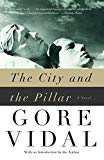
The major theme of the novel is how prejudice creates the object of its own hatred, and in the process damages not only the oppressed, but also society at large. The protagonist is a potentially well adjusted individual who is forced, by society's neurotic attitude to sex in general and to sex between men in particular, into a pattern of behaviors that precludes happiness or fulfillment, and eventually leads to a destructive denouement. The origin of society's perverse attitude to sex is subtly traced to religion (both by the epigraph opening the novel, which is the end of the biblical passage describing the destruction of Sodom, and by remarks scattered in the narrative by different characters, who voice Vidal's idea that humans are naturally bisexual, and this natural inclination is perverted by cultural superstructures).
Another theme is the portrayal of the homosexual man as masculine. Vidal set out to break the mould of novels that up until The City and the Pillar depicted homosexuals as transvestites, lonely bookish boys, or feminine. Vidal purposefully makes his protagonist a strong athlete to challenge superstitions, stereotypes, and prejudices about sex in the United States. To further this theme Vidal wrote the novel in plain, objective prose in order to convey and document reality.
Two additional themes identified by Dennis Bolin are the foolishness and destructiveness of wishing for something that can never be and to waste one's life dwelling on the past, the second of which is reinforced by the novel's epigraph from the Book of Genesis 19:26 "But his wife looked back from behind him and she became a pillar of salt."
Already have an account? Log In Now